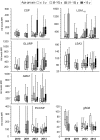Longitudinal analysis of antibody responses in symptomatic malaria cases do not mirror parasite transmission in peri-urban area of Cote d'Ivoire between 2010 and 2013
- PMID: 28245264
- PMCID: PMC5330500
- DOI: 10.1371/journal.pone.0172899
Longitudinal analysis of antibody responses in symptomatic malaria cases do not mirror parasite transmission in peri-urban area of Cote d'Ivoire between 2010 and 2013
Abstract
Background: In the agenda towards malaria eradication, assessment of both malaria exposure and efficacy of anti-vectorial and therapeutic strategies is a key component of management and the follow-up of field interventions. The simultaneous use of several antigens (Ags) as serological markers has the potential for accurate evaluation of malaria exposure. Here we aimed to measure the longitudinal evolution of the background levels of immunity in an urban setting in confirmed clinical cases of malaria.
Methods: A retrospective serological cross-sectional study on was carried out using 234 samples taken from 2010 to 2013 in peri-urban sentinel facility of Cote d'Ivoire. Antibody responses to recombinant proteins or BSA-peptides, 8 Plasmodium falciparum (PfAMA1, PfMSP4, PfMSP1, PfEMP1-DBL1α1-PF13, PfLSA1-41, PfLSA3-NR2, PfGLURP and PfCSP), one P. malariae (PmCSP) and one Anopheles gambiae salivary (gSG6-P1) antigens were measured using magnetic bead-based multiplex immunoassay (MBA). Total anti- P. falciparum IgG responses against schizont lysate from african 07/03 strain (adapted to culture) and 3D7 strain was measured by ELISA.
Results: High prevalence (7-93%) and levels of antibody responses to most of the antigens were evidenced. However, analysis showed only marginal decreasing trend of Ab responses from 2010 to 2013 that did not parallel the reduction of clinical malaria prevalence following the implementation of intervention in this area. There was a significant inverse correlation between Ab responses and parasitaemia (P<10-3, rho = 0.3). The particular recruitment of asymptomatic individuals in 2011 underlined a high background level of immunity almost equivalent to symptomatic patients, possibly obscuring observable yearly variations.
Conclusion: The use of cross-sectional clinical malaria surveys and MBA can help to identify endemic sites where control measures have unequal impact providing relevant information about population immunity and possible decrease of transmission. However, when immunity is substantially boosted despite observable clinical decline, a larger cohort including asymptomatic recruitment is needed to monitor the impact of control measures on level of immunity.
Conflict of interest statement
Figures




References
-
- WHO. WHO World Malaria Report 2014. http://wwwwhoint/malaria/publications/world_malaria_report_2014/en/. 2014;(Dec 17,2012).
-
- WHO. WHO World Malaria Report 2010, 2011, 2013. http://wwwwhoint/malaria/publications/. 2010,2011,2013.
-
- Crompton PD, Kayala MA, Traore B, Kayentao K, Ongoiba A, Weiss GE, et al. A prospective analysis of the Ab response to Plasmodium falciparum before and after a malaria season by protein microarray. Proc Natl Acad Sci U S A. 2010;107(15):6958–63. Epub 2010/03/31. 10.1073/pnas.1001323107 - DOI - PMC - PubMed
MeSH terms
Substances
LinkOut - more resources
Full Text Sources
Other Literature Sources

